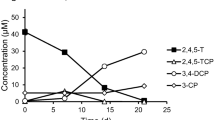Abstract
Anaerobic transformations of 1,1,1-trichloroethane (TCA), 1,1-dichloroethane (DCA), and chloroethane (CA) were studied with sludge from a lab-scale, municipal wastewater sludge digester. TCA was biologically transformed to DCA and CA and further to ethane by reductive dechlorination. TCA was also converted to acetic acid and 1,1-dichloroethene (11DCE) by cell-free extract. 11DCE was further biologically converted to ethene. This pathway was confirmed by transformation tests of TCA, DCA and CA, by tests with cell-free extract, and by chloride release during TCA degradation. With cell-free extract, acetic acid accounted for approximately 90% of the TCA transformed; tests with live cells indicate that the fraction of TCA transformed by this pathway decreased with lower biomass. The dechlorination of DCA to CA and CA to ethane was not stoichiometric. A high rate of TCA removal was observed under the experimental conditions. The results indicate that removal of TCA in anaerobic digestion should be complete, but DCA and CA could persist in a normally operating digester.
Similar content being viewed by others
References
Ballapragada BS, Puhakka JA, Stensel HD & Ferguson JF (1995) Development of tetrachloroethene transforming anaerobic cultures from municipal digester sludge. In: Hinchee RE, Leeson A, Semprini L (Eds) Bioremediation of Chlorinated Solvents (pp 91–98). Battelle Press, Columbus, Ohio
Ballapragada BS, Stensel HD, Magar VS & Ferguson JF (1998) Toxic chlorinated compounds: Fate and biodegradation in anaerobic digestion, Project 91-TFT-3, Water Environment Research Foundation (D80000), Alexandria, Virginia
Blum DJW and Speece R E (1991) A database of chemical toxicity to environmental bacteria and its use in intercepts comparisons and correlations. Res. J. Water Pollut Control Fed. 63: 198–207
Bouwer EJ and McCarty PL (1983) Transformation of 1-and 2-carbon halogenated aliphatic organic compounds under methanogenic conditions. Appl. Environ. Microbiol. 45: 1286–1294
Cline PV & Delfino JJ (1989) Transformation kinetics of 1,1,1-trichloroethane to the stable product 1,1-dichloroethene. In: Biohazards of Drinking Water Treatment (pp 47–56). Lewis Publishers, Chelsea, Michigan
Egli C, Scholtz R, Cook AM & Leisinger T (1983) Anaerobic dehalogenation of tetrachloromethane and 1,2-dichloroethane to degradable products by pure cultures of Desulfobacterium sp. and Methanobacterium sp. FEMS Microbiol. Lett. 43: 257–261
Jeffers PM, Ward LM, Woytowitch LM & Wolfe NL (1989) Homogeneous hydrolysis rate constants for selected chlorinated methanes, ethanes, ethenes, and propanes. Environ. Sci. Technol. 23: 965–969
Galli R & McCarty PL (1989) Biotransformation of 1,1,1-trichloroethane, trichloromethane, and tetrachloromethane by a Clostridium sp. Appl. Environ. Microbiol. 55: 837–844
Gossett JM (1987) Measurement of Henry's constants for C1 and C2 chlorinated hydrocarbons. Environ. Sci. Technol. 21: 202–208
Klecka GM, Gonsior SJ & Markham DA (1990) Biological transformations of 1,1,1-trichloroethane in subsurface solid and ground water. Environ. Tox. Chem. 9: 1473–1451
McCarty PL & Semprini L (1994) Ground-water treatment for chlorinated solvents, Section 5 in Handbook of Bioremediation, Lewis Publishers, Boca Raton, Florida.
Owen WF, Stuckey DC, Healy JB, Young LY & McCarty PL (1979) Bioassay for monitoring biochemical methane potential and anaerobic toxicity. Water Res. 13: 485–492.
Parsons F, Lage GB & Rice R (1985) Biotransformation of chlorinated organic solvents in static microcosms. Environ. Toxicol. Chem. 4: 739–742
Perkins PS, Komisar SJ, Puhakka JA & Ferguson JF (1994) Effects of electron donors and inhibitors on reductive dechlorination of 2,3,6-trichlorophenol. Res. 28: 2101–2107
Shelton DR & Tiedje JM (1984) General method for determining anaerobic biodegradation potential. App. Environ. Microbiol. 47: 850–857
USEPA, Office of Pollution Prevention and Toxics(TS-799) (1991) 1991 Toxics Release Inventory. — Public Data Release, Washington, DC
Van Eekert MHA, Stams AJM, Field JA & Schraa G (1999) Gratuitous dechlorination of chloroethanes by methanogenic granular sludge. Appl. Microbiol. Biotechnol. 51: 46–52
Vogel TM & McCarty PL (1987a) Abiotic and biotic transformations of 1,1,1-trichloroethane under methanogenic conditions. Environ. Sci. Technol. 21: 1208–1213
Vogel TM & McCarty PL (1987b) Rate of abiotic formation of 1,1,1-dichloroethylene from 1,1,1-trichloroethane in groundwater. J. Contam. Hydrol. 1: 299–308
Westrick JJ, Mello JW & Thomas RF (1984) The groundwater supply survey. J. Am. Wat. Works Assoc. 76(5): 52–59.
Author information
Authors and Affiliations
Rights and permissions
About this article
Cite this article
Chen, C., Ballapragada, B., Puhakka, J. et al. Anaerobic transformation of 1,1,1-trichloroethane by municipal digester sludge. Biodegradation 10, 297–305 (1999). https://doi.org/10.1023/A:1008336103968
Issue Date:
DOI: https://doi.org/10.1023/A:1008336103968




